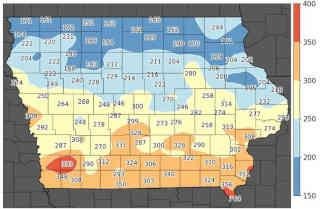By Ashley Dean and Erin Hodgson
Iowa’s most significant soybean insect pest, the soybean aphid, alternates between two hosts to complete its development. The primary host of soybean aphid is buckthorn, an invasive shrub often found in hedgerows and roadside ditches, and its secondary host is soybean. For most of the year, soybean aphids exist as cold-hardy eggs on buckthorn branches near leaf buds. For many aphids that overwinter as an egg, hatching happens when the host resumes spring growth. If eggs hatch too soon, aphids can suffer mortality from starvation because they feed on phloem from actively growing tissue.
We can track soybean aphid development using growing degree days (GDD), and research has shown that eggs hatch around the time buckthorn buds swell. Soybean aphid egg hatch occurs between 147-154 degree days (base 50°F) and buckthorn bud swell happens shortly after that (165-171 degree days). Based on air temperatures in 2023 (Figure 1), egg hatch is complete in northern Iowa, where most of the buckthorn in Iowa is located, and buckthorn bud swell is likely happening now.
